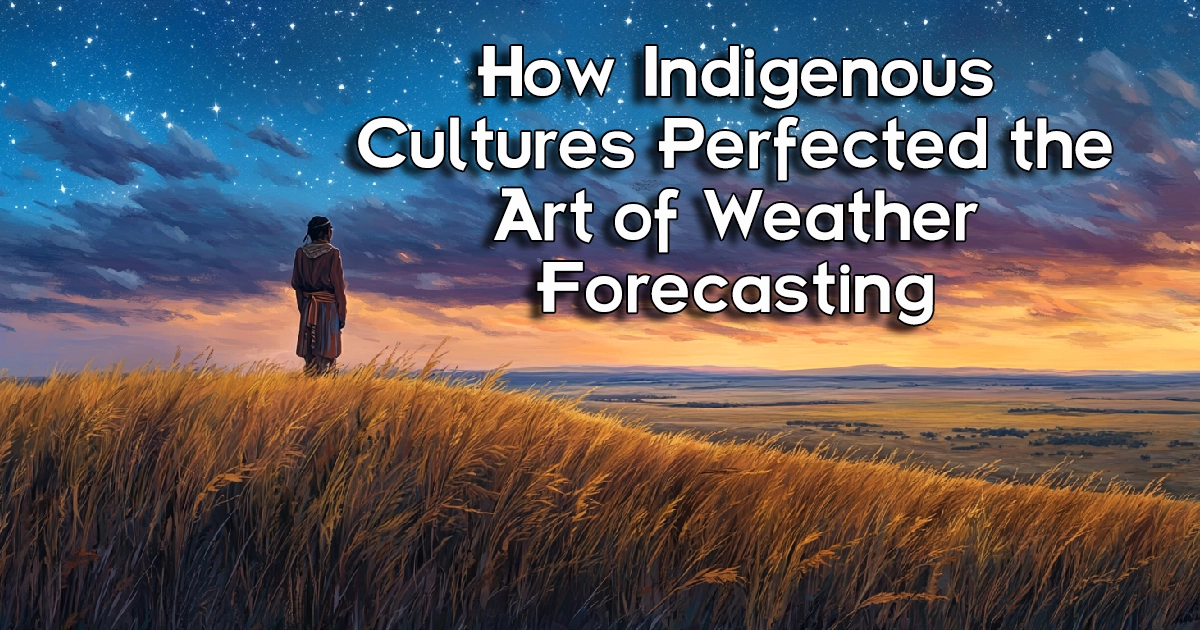

Long before weather apps and satellite systems tracked storm patterns from space, ancient cultures around the world were already reading the skies, land, and animals to predict weather changes. In places where survival often hinged on knowing when the rains would come or when a harsh winter would set in, indigenous peoples developed sophisticated methods of weather forecasting that still amaze us today.
From the Inuit of the Arctic to the Aboriginal people of Australia, indigenous weather forecasting wasn’t just about survival—it was an intricate practice rooted in deep knowledge of the natural world. Let’s journey through some of the fascinating techniques these cultures used to forecast the weather, methods passed down through generations and proven by time.

The Arctic, with its brutal cold and rapidly shifting conditions, is one of the harshest environments on Earth. Yet, for thousands of years, the Inuit people have thrived in this frozen landscape. How? By reading the environment around them with incredible precision.
The Inuit have long been able to predict weather changes by observing the behavior of animals, the direction of the wind, and even the appearance of the sky. For instance, they believe that when sea birds fly closer to land, a storm is approaching. Similarly, if the ice forms in certain ways or cracks in specific patterns, it can signal a shift in weather patterns. These signs allowed the Inuit to anticipate incoming storms and dangerous weather, giving them enough time to prepare or seek shelter.
Inuit hunters, traveling over the treacherous ice, often rely on the color of the sky. A red sky in the morning means bad weather, while a red sky at night is seen as a sign of clear weather. This technique, similar to Western sayings, has been proven effective in predicting short-term weather changes.

In the vastly different but equally challenging landscapes of Australia, Aboriginal people have developed their own unique ways of forecasting weather. For them, nature is a living entity, offering signs and signals that, if interpreted correctly, can predict rain, drought, or seasonal shifts.
One well-known example is the Yolngu people from northern Australia, who can predict the arrival of the monsoon season by observing the flowering of specific plants or the migration of animals. For them, the blooming of a certain flower or the movement of a species of birds signals the rains that will soon come.
Another fascinating technique involves watching ants. In many Aboriginal cultures, if ants are seen building their nests higher than usual, it’s believed to be a sign of upcoming heavy rains. These observations, rooted in centuries of experience, are not just folklore—they’ve been validated by scientists who study the correlation between animal behavior and weather.

In the vast plains of North America, the Lakota people have long relied on the wind and stars to help them predict the weather. The direction and strength of the wind are key indicators of how the weather will change. When the wind blows from a certain direction for long periods, it suggests the arrival of a storm or a significant temperature shift.
The Lakota also use the stars to track the seasons and predict when weather changes will occur. By watching the position of constellations, they know when it's time to prepare for winter or when the spring rains will begin. For them, weather forecasting was not just about survival but also deeply intertwined with their spiritual beliefs.

In New Zealand, the Māori people have developed an intricate understanding of their environment, especially the birds and the clouds. The Māori say that the behavior of certain birds, particularly the shining cuckoo, can predict the arrival of summer. If the cuckoo sings early in the season, a warm and dry summer is expected.
Cloud formations are another key tool for Māori weather forecasting. Large, towering clouds on the horizon signal rain or even storms, while low, flat clouds indicate calm weather ahead. This skill is especially important for the Māori, who have long relied on the land for agriculture and fishing.
What’s remarkable about these indigenous weather forecasting techniques is that they’re based on long-term observation, something modern science is only recently starting to fully appreciate. By studying their environments so closely, these ancient cultures developed methods of predicting weather that often rival modern meteorology.
In some places, like northern Australia, indigenous weather knowledge is still actively used alongside modern technology. Scientists are now recognizing the value of this ancient wisdom and how it can complement modern weather prediction, especially in areas where traditional forecasting tools fall short.
Today, as climate change creates more unpredictable weather patterns around the world, perhaps we have much to learn from these ancient cultures. They show us that understanding and respecting the natural world can provide powerful tools for predicting the future—whether that’s knowing when the next storm will arrive or how the environment around us is changing.
Today's world is driven by data and technology, the wisdom of indigenous peoples reminds us of the importance of observation, patience, and a deep connection to the Earth. The ancient practice of weather forecasting, once a matter of life and death, is now a legacy that offers valuable insights into how we might navigate the climate challenges ahead.